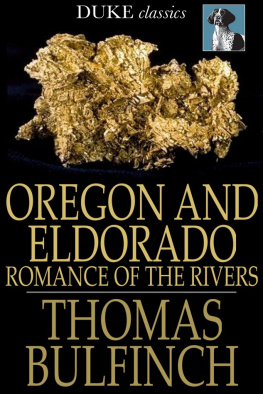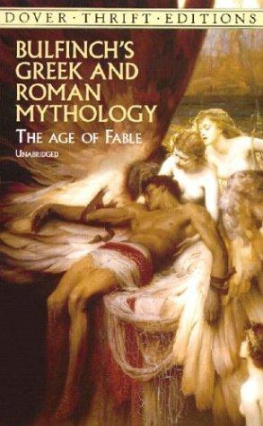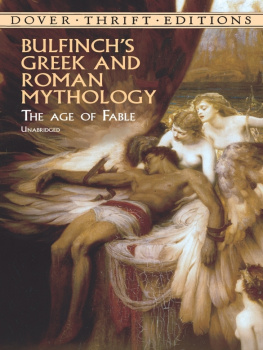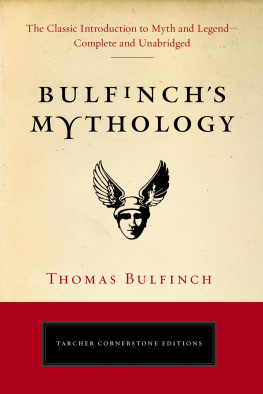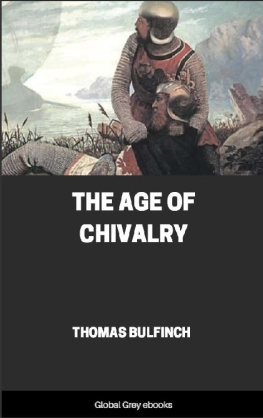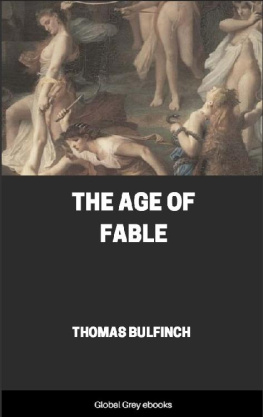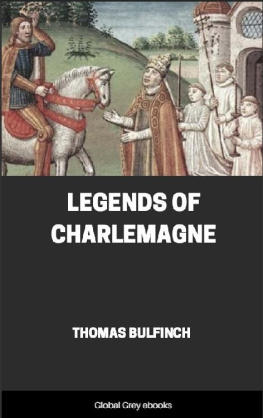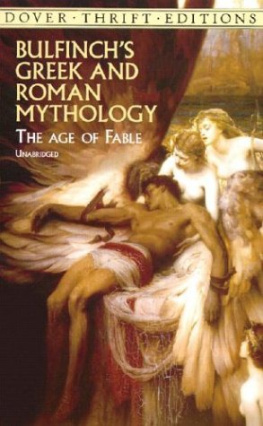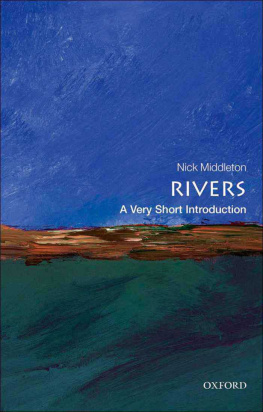OREGON AND ELDORADO
ROMANCE OF THE RIVERS
* * *
THOMAS BULFINCH
*
Oregon and Eldorado
Romance of the Rivers
First published in 1866
ISBN 978-1-62012-939-5
Duke Classics
2012 Duke Classics and its licensors. All rights reserved.
While every effort has been used to ensure the accuracy and reliability of the information contained in this edition, Duke Classics does not assume liability or responsibility for any errors or omissions in this book. Duke Classics does not accept responsibility for loss suffered as a result of reliance upon the accuracy or currency of information contained in this book.
Contents
*
Preface
*
When one observes attentively the maps of South and North America, nofeature appears more striking than the provision which Nature seems tohave made, in both continents, for water-communication across thebreadth of each. In the Northern continent, this channel ofcommunication is formed by the Missouri and Columbia Rivers, whichstretch over an extent of three thousand miles, interrupted only by theridge of the Rocky Mountains. In the Southern continent, the RiverAmazon, in its path from the Andes to the sea, traverses a course ofthirty-three hundred miles. In both cases, a few hundred miles ofland-carriage will complete the transit from ocean to ocean. The analogypresented in the length and direction of these magnificentwater-pathways is preserved in their history. A series of romanticadventures attaches to each. I indulge the hope, that young readers whohave so favorably received my former attempts to amuse and instructthem, in my several works reviving the fabulous legends of remote ages,will find equally attractive these true narratives of bold adventure,whose date is comparatively recent. Moreover, their scenes are laid, inthe one instance, in our own country; and, in the other, in that greatand rising empire of Brazil to which our distinguished naturalist, Prof.Agassiz, has gone on a pilgrimage of science. It will enable us betterto appreciate the discoveries and observations which the professor willlay before us on his return, to know something beforehand of the historyand peculiarities of the region which is the scene of his labors; and,on the other hand, the route across the North-American continent, towhich the first part of the volume relates, deprives increased interest,at this time, from the fact that it nearly corresponds to the route ofthe contemplated Northern Pacific Railroad.
BOSTON, June, 1866. T. B.
OREGON
*
Chapter I - Discovery of Columbia River
*
A few years ago, there was still standing in Bowdoin Square, Boston,opposite the Revere House, an ancient mansion, since removed to makeroom for the granite range called the Coolidge Building. In thatmansion, then neither old nor inelegant, but, on the contrary, havinggood pretensions to rank among the principal residences of the place,was assembled, in the year 1787, a group, consisting of the master ofthe mansion, Dr. Bulfinch, his only son Charles, and Joseph Barrell,their neighbor, an eminent merchant of Boston. The conversation turnedupon the topic of the day,the voyages and discoveries of Capt. Cook,the account of which had lately been published. The brilliantachievements of Capt. Cook, his admirable qualities, and his sad fate(slain by the chance stroke of a Sandwich-Islander, in a sudden brawlwhich arose between the sailors and the natives),these formed thecurrent of the conversation; till at last it changed, and turned moreupon the commercial aspects of the subject. Mr. Barrell was particularlystruck with what Cook relates of the abundance of valuable furs offeredby the natives of the country in exchange for beads, knives, and othertrifling commodities valued by them. The remark of Capt. Cook respectingthe sea-otter was cited:
"This animal abounds here: the fur is softer and finer than that of anyother we know of; and therefore the discovery of this part of thecontinent, where so valuable an article of commerce may be met with,cannot be a matter of indifference." He adds in a note, "The sea-otterskins are sold by the Russians to the Chinese at from sixteen to twentypounds each."
Mr. Barrell remarked, "There is a rich harvest to be reaped there bythose who shall first go in." The idea thus suggested was followed outin future conversations at the doctor's fireside, admitting othercongenial spirits to the discussion, and resulted in the equipping of anexpedition consisting of two vessels, the ship "Columbia" and sloop"Washington," to make the proposed adventure. The partners in theenterprise were Joseph Barrell, Samuel Brown, Charles Bulfinch, JohnDerby, Crowell Hatch, and J. M. Pintard. So important was the expeditiondeemed by the adventurers themselves, that they caused a medal to bestruck, bearing on one side a representation of the two vessels undersail, and on the other the names of the parties to the enterprise.Several copies of this medal were made both in bronze and silver, anddistributed to public bodies and distinguished individuals. One of thesemedals lies before the writer as he pens these lines.
The expedition was also provided with sea-letters, issued by the FederalGovernment agreeably to a resolution of Congress, and with passportsfrom the State of Massachusetts; and they received letters from theSpanish minister plenipotentiary in the United States, recommending themto the attention of the authorities of his nation on the Pacific coast.
The "Columbia" was commanded by John Kendrick, to whom was intrusted thegeneral control of the expedition. The master of the "Washington" wasRobert Gray.
The two vessels sailed together from Boston on the 30th of September,1787: thence they proceeded to the Cape Verde Islands, and thence to theFalkland Islands, in each of which groups they procured refreshments. InJanuary, 1788, they doubled Cape Horn; immediately after which they wereseparated during a violent gale. The "Washington," continuing her coursethrough the Pacific, made the north-west coast in August, near the 46thdegree of latitude. Here Capt. Gray thought he perceived indications ofthe mouth of a river; but he was unable to ascertain the fact, inconsequence of his vessel having grounded, and been attacked by thesavages, who killed one of his men, and wounded the mate. But sheescaped without further injury, and, on the 17th of September, reachedNootka Sound, which had been agreed upon as the port of re-union in caseof separation. The "Columbia" did not enter the sound until some daysafterward.
The two vessels spent their winter in the sound; where the "Columbia"also lay during the following summer, collecting furs, while Capt.Gray, in the "Washington," explored the adjacent waters. On his returnto Nootka, it was agreed upon between the two captains that Kendrickshould take command of the sloop, and remain on the coast, while Gray,in the "Columbia," should carry to Canton all the furs which had beencollected by both vessels. This was accordingly done; and Gray arrivedon the 6th of December at Canton, where he sold his furs, and took in acargo of tea, with which he entered Boston on the 10th of August, 1790,having carried the flag of the United States for the first time roundthe world.
Kendrick, immediately on parting with the "Columbia," proceeded with the"Washington" to the Strait of Fuca, through which he sailed, in itswhole length, to its issue in the Pacific, in lat. 51. To him belongsthe credit of ascertaining that Nootka and the parts adjacent are anisland, to which the name of Vancouver's Island has since been given,which it now retains. Vancouver was a British commander who followed inthe track of the Americans a year later. The injustice done to Kendrickby thus robbing him of the credit of his discovery is but one of manysimilar instances; the greatest of all being that by which ourcontinent itself bears the name, not of Columbus, but of a subsequentnavigator.

